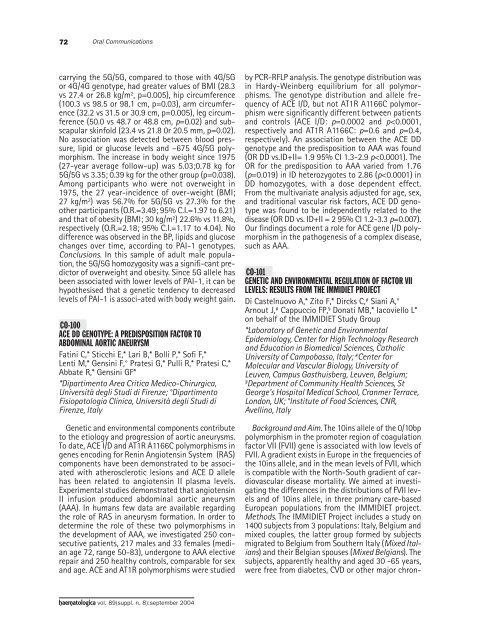Haematologica 2004;89: supplement no. 8 - Supplements ...
Haematologica 2004;89: supplement no. 8 - Supplements ...
Haematologica 2004;89: supplement no. 8 - Supplements ...
- No tags were found...
Create successful ePaper yourself
Turn your PDF publications into a flip-book with our unique Google optimized e-Paper software.
72Oral Communicationscarrying the 5G/5G, compared to those with 4G/5Gor 4G/4G ge<strong>no</strong>type, had greater values of BMI (28.3vs 27.4 or 26.8 kg/m 2 , p=0.005), hip circumference(100.3 vs 98.5 or 98.1 cm, p=0.03), arm circumference(32.2 vs 31.5 or 30.9 cm, p=0.005), leg circumference(50.0 vs 48.7 or 48.8 cm, p=0.02) and subscapularskinfold (23.4 vs 21.8 0r 20.5 mm, p=0.02).No association was detected between blood pressure,lipid or glucose levels and –675 4G/5G polymorphism.The increase in body weight since 1975(27-year average follow-up) was 5.03;0.78 kg for5G/5G vs 3.35; 0.39 kg for the other group (p=0.038).Among participants who were <strong>no</strong>t overweight in1975, the 27 year-incidence of over-weight (BMI;27 kg/m 2 ) was 56.7% for 5G/5G vs 27.3% for theother participants (O.R.=3.49; 95% C.I.=1.97 to 6.21)and that of obesity (BMI; 30 kg/m 2 ) 22.6% vs 11.8%,respectively (O.R.=2.18; 95% C.I.=1.17 to 4.04). Nodifference was observed in the BP, lipids and glucosechanges over time, according to PAI-1 ge<strong>no</strong>types.Conclusions. In this sample of adult male population,the 5G/5G homozygosity was a signifi-cant predictorof overweight and obesity. Since 5G allele hasbeen associated with lower levels of PAI-1, it can behypothesised that a genetic tendency to decreasedlevels of PAI-1 is associ-ated with body weight gain.CO-100ACE DD GENOTYPE: A PREDISPOSITION FACTOR TOABDOMINAL AORTIC ANEURYSMFatini C,* Sticchi E,* Lari B,* Bolli P,* Sofi F,*Lenti M,* Gensini F,° Pratesi G,* Pulli R,* Pratesi C,*Abbate R,* Gensini GF**Dipartimento Area Critica Medico-Chirurgica,Università degli Studi di Firenze; °DipartimentoFisiopatologia Clinica, Università degli Studi diFirenze, ItalyGenetic and environmental components contributeto the etiology and progression of aortic aneurysms.To date, ACE I/D and AT1R A1166C polymorphisms ingenes encoding for Renin Angiotensin System (RAS)components have been demonstrated to be associatedwith atherosclerotic lesions and ACE D allelehas been related to angiotensin II plasma levels.Experimental studies demonstrated that angiotensinII infusion produced abdominal aortic aneurysm(AAA). In humans few data are available regardingthe role of RAS in aneurysm formation. In order todetermine the role of these two polymorphisms inthe development of AAA, we investigated 250 consecutivepatients, 217 males and 33 females (medianage 72, range 50-83), undergone to AAA electiverepair and 250 healthy controls, comparable for sexand age. ACE and AT1R polymorphisms were studiedby PCR-RFLP analysis. The ge<strong>no</strong>type distribution wasin Hardy-Weinberg equilibrium for all polymorphisms.The ge<strong>no</strong>type distribution and allele frequencyof ACE I/D, but <strong>no</strong>t AT1R A1166C polymorphismwere significantly different between patientsand controls (ACE I/D: p=0.0002 and p
















